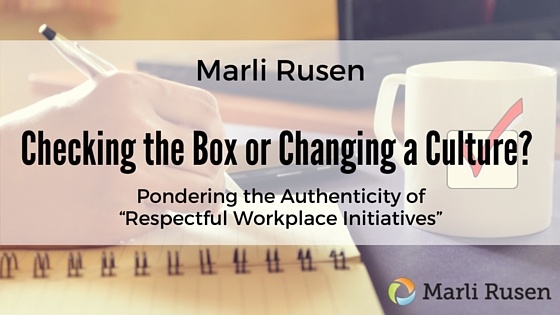Resources > Blog > Checking the Box or Changing a Culture? Pondering the Authenticity of “Respectful Workplace Initiatives”

As many of you know, I spend a lot of time working closely with organizations on improving their overall workplace environment and culture. Whatever the specific issue being investigated or subject being taught – human rights, supervisory authority, bullying/harassment, labour relations or otherwise – my focus is on how to improve the HOW of the workplace – how we speak to and about each other and how we treat each other generally in the decisions we make and in our day-to-day interactions – both personal and professional.
For me, truly successful organizations commit to “doing the right thing in the right way”, not because they have to, but because they choose to for the sake of their leaders, staff and organization overall. Increasingly, this organizational commitment reflects the evolving legal realities surrounding workplace respect. Safety tribunals, Human Rights Tribunals, courts and arbitrators have made it clear that workers and leaders are entitled to respectful, safe and discrimination-free workplaces. This means, of course, that everyone is expected to conduct themselves in a respectful and civil manner. (Sometimes those who speak of their “entitlement” to a respectful workplace pay little attention to their corresponding responsibilities).
Regrettably, I continue to hear a lot of talk about respect, with relatively less “walk”. A minimalist, narrow and overly-technical approach to building respect seems to be the rule in some workplaces. A common sentiment in this regard is “We’ll do what we are forced to do to ensure we are “technically compliant” with the laws and legislation surrounding this matter – and nothing more”.
As a result, many organizations remain wilfully blind to leaders and staff who are engaged in persistently subtle, underhanded, and apparently “difficult-to-detect” disrespect (I say apparently because, in many matters in which I have been involved, such behaviours have not been difficult to detect by those who have been forced to cope with them; they only have been difficult to detect by those with the authority to take action). The workplace waits until the victim/aggressor leaves the workplace or the behaviour “crystallizes” into a more significant event and becomes “more tangible” (through a “formal” complaint, lawsuit or otherwise).
This approach flies in the face of the legal expectation that individuals working in any workplace, at least in BC, take reasonable steps to “prevent or minimize bullying and harassment”. This responsibility to act early and proactively attaches to all workers – perceived victims, perceived aggressors, bystanders and leaders. If individuals are aware of behaviours that, if left unchecked, may become bullying, then the organization must inquire into such behaviour when it arises. Further, that inquiry must be done in an objective manner by a neutral decision-maker (one with no perceived or actual involvement or interest in any of the issues at play). No exceptions, no excuses.
A narrow, conservative, “wait and see” attitude is not only inconsistent with formal legal expectations, it often results in the departure of skilled, competent and highly sought after individuals (staff and leaders) who leave workplaces because of the toxicity that has been allowed to develop on their teams. Over time, “that team” or “that department” becomes known for its disrespectful unhealthy atmosphere and high turnover. This results in significant challenges with attraction and retention of strong staff. Simply put, the dysfunctional communication and behaviour of only one or two individuals – if left unaddressed – can destroy the productivity, profitability and success of an entire organization.
While profits and productivity are fundamental to success, they are directly connected to the willingness and capacity of those in the workplace to produce. Engaged, respected and supported staff – including leaders – are the foundation to any thriving organization or endeavour. Take care of them, not only because legislation demands that you do so – but because it is the right thing to do.
What does walking the talk of respect look like?
- Commit to a respectful workplace culture;
- Commit to becoming aware of and responsive to concerns about communication and conduct perceived as inconsistent with a respectful workplace culture;
- Ensure that “allegations” of disrespect are treated as that – allegations, not fact – and are reviewed in an objective and confidential manner by someone who has no involvement or interest in the circumstances being considered;
- Ensure that the person being accused of any type of disrespect or dysfunction (poor performance, communication, conduct or otherwise) is given a full, fair and genuine opportunity to be heard; and
- Take the time to truly discover all of the dynamics giving rise to a dysfunctional situation. Remember that, unlike discreet instances of workplace misconduct, workplace disrespect is commonly multi-layered, with many individuals contributing to the dysfunction in different ways. A truly respectful workplace unpacks these complexities – through a respectful, objective and timely inquiry – to ensure that each layer of dysfunction is accurately identified and addressed as soon as reasonably possible.
- They say that talk is cheap. However, when it comes to workplace disrespect, talk alone is very expensive. Walk the talk of respect – and watch as your organization’s costs drop and profits and productivity soar.
– Marli Rusen
Marli Rusen has published a book “THE MIRROR METHOD – How to Build a Productive Team by Ending Workplace Dysfunction” coming out in September.
